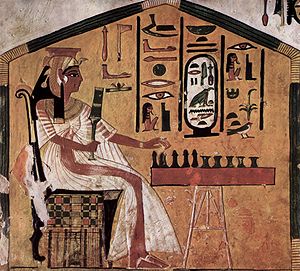Society: The game of Senet
The ancient Egyptians engaged in various leisure activities for enjoyment. Among these, board games were a popular pastime. The most renowned board game of that era was Senet, which was widely played during their free time.
In the picture Queen Nefertari playing Senet at her tomb in the Valley of the Queens.
Senet, an ancient Egyptian game, has been played since the earliest times of a unified Egypt. Evidence of its antiquity includes a depiction on the wall of Hesy-ra's mastaba from the third dynasty. Hesy-ra served as the scribe supervisor for King Djoser, and this reference highlights the game's longstanding presence. Additionally, inscriptions related to two other games, mehen and men, have been discovered.
Throughout Egypt's history, Senet boards have been unearthed in numerous tombs, dating back to the pre-dynastic era. The most notable discovery was in Tutankhamun's tomb, where five Senet boards were found. These boards were typically crafted from materials such as wood, ivory, or faience. The name 'Senet' translates to 'pass' or 'proceed,' reflecting the gameplay's objective.
Approximately 100 Senet boards have been recovered, either whole or in fragments. While some boards feature unique squares with specific roles, five squares remain consistent across all known boards—the final five.
Senet is a two-player game featuring a board divided into three rows of ten squares each. Players can use five or ten pieces, depending on the game variant, and some versions even allow seven pieces. The pieces are differentiated by shape—conical or cylindrical—and color—light or dark. Although this was the standard design, excavations have revealed pieces in various colors. The squares traversed by the pieces are referred to as 'peru,' meaning 'houses.'
The aim of the game is to remove the opponent's pieces from the board. The movement of the pieces is not dictated by dice but by four sticks or boards. These sticks are plain on one side and marked on the other, either black or with various symbols. When thrown, a player advances by the number of sticks that land with the marked side facing up, allowing movement of up to four spaces in one turn. However, if all sticks land on the marked side, the player moves six spaces.
A player earns an additional turn whenever they advance 1, 3, or 6 spaces, continuing until they roll a 2 or 4. Two pieces from the same player positioned on adjacent squares provide mutual protection and cannot be captured by an opponent. Three consecutive pieces form a barrier that opponents cannot pass—only their own pieces can leap over them. An opponent's piece is captured by landing on the same square with an exact roll; merely passing by does not result in capture. Capturing causes the pieces to swap positions on the board. If forward movement is not possible, a piece must move backward.
Image of the mastaba of Hesy-ra in Saqqara where the oldest representation of the Senet has been documented.
Throughout the board, there are a series of special squares, each with its own rules, spanning from square 26 to 30. For instance, square 26 (nefer) grants the player an extra turn, while square 27 (water) sends the player's token back to the starting square. Squares 28, 29, and 30 display the number of squares remaining to exit the board, with numerical references: 3, 2, and 1 (men, birds, etc.), possibly indicating that drawing the exact number is necessary to do so.
During the Middle Kingdom, boards have been discovered where the decorated squares are in the upper left corner rather than the lower right, suggesting that gameplay proceeded in the opposite direction compared to boards from other periods.
It's important to consider that we cannot be certain these were the actual rules of the game since no definitive rule set has survived. Therefore, what is practiced today is a consensual method of play that has been established over time.
The game is linked with the journey to the afterlife, with players navigating through dangers represented by the squares and special squares on the board. Thus, beyond being a mere game, Senet should be seen as a significant cultural element that at times in history was deemed important enough to accompany the deceased to their tomb or to adorn tomb walls with images of the game.
This interpretation is further supported by chapter 17 of the Book of the Dead, wherein the deceased is depicted playing Senet against an invisible adversary.
Presently, Senet boards are available for purchase in various stores, allowing people to reenact this ancient Egyptian leisure activity. The example shown in the following illustration can be found on Amazon.
In the same way, we can find mobile applications in which to recreate this popular hobby. Below you can find the link to a couple of them with which you can familiarize yourself with the rules and have a good time.
OTHER SOCIETY ENTRIES:







Comments
Post a Comment